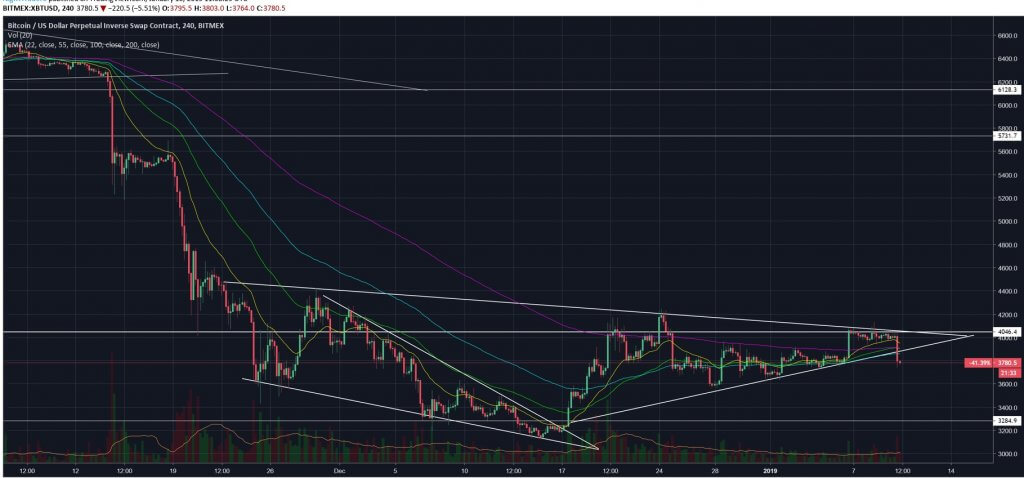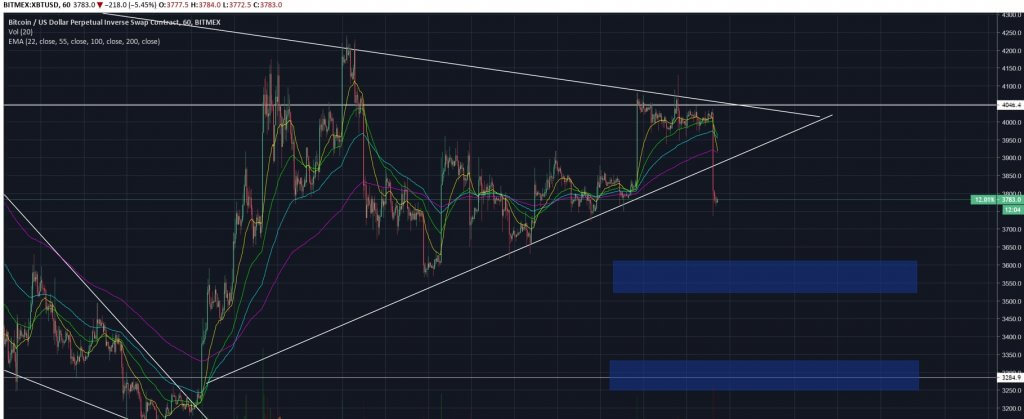After three days of valiantly attempting to break out of the $4,050 level of resistance, Bitcoin slumped to a 5% move to the downside on Thursday. Interestingly, there was no news or fundamental changes that affected price action, demonstrating the fragility of this immature asset class.
Volatility in cryptocurrency isn’t a new concept. Bitcoin and the more illiquid altcoins often make substantial moves in either direction without a real catalyst. While this is attractive to day traders, it really diminishes Bitcoin’s status as a store of value and an international payment service.
The claim of Bitcoin advocates is that Bitcoin will revolutionise cross-border money transfers, but when price can move 5% in a 30-minute period when a transaction is being confirmed, it hardly represents value or stability.
Bitcoin succumbs to selling pressure

Having flirted with the prospect of a breakout from the $4,050 level of resistance for a number of days, the amount of buy volume simply wasn’t enough to catapult Bitcoin towards the next level of resistance at $4,400. The breakdown in price action coincided with a break of the diagonal trend line that formed on December 17th, with further downside movement now looking most likely. If $3,755 breaks, the next meaningful levels of support are at $3,550 and $3,250.
The inverse head-and-shoulders that much of the cryptocurrency community had hoped to play out has been invalidated by this latest move to the downside. In fact, it was invalidated weeks ago as the volume on the neck line didn’t match that of a true head-and-shoulders reversal pattern.
Bitcoin’s decline caused a sea of red across the cryptocurrency boards, with Bitcoin Cash falling 15% while Ethereum also recorded a double-digit move to the downside. The explosive fall in price saw more than $10 billion wiped from the entire cryptocurrency market cap.
Fall was speculative sentiment-based and not news-based

In legacy markets, price action is driven by news from listed companies. Quarterly earning reports, company restructures, and global partnerships are often catalysts for market moves. In cryptocurrency, however, price moves based on speculation and overall sentiment. The reliance on sentiment-driven price action is a cause for the wild volatility seen in the cryptocurrency markets. It means that when an actual news story relating to cryptocurrency breaks, price will swing far more than on legacy markets which typically have more liquidity.
Sentiment in cryptocurrency is amplified by regulatory news. Due to the US government’s shutdown over the past month, regulatory news has been slow in the cryptocurrency space. Before the shutdown, the SEC clearly showed their gung-ho stance in terms of regulating ICOs, but this has now fallen by the wayside as uncertainty grips the US.
The Intercontinental Exchange (ICE) are planning to launch their Bitcoin futures product, Bakkt, at the end of this month. However, it is still subject to approval from the CFTC, who are expected to delay the decision. The SEC also have a big decision to make at the end of February as it is the deadline for VanEck and SolidX’s Bitcoin ETF applications. If these are approved, it will most certainly add legitimacy to the space, but a rejection could cause severe price action to the downside with a potential breakdown from yearly lows.
Where is Bitcoin heading next?

The break of the $6,100 level of support in November was significant. It demonstrated that the bear market was nowhere near its end. In fact, it showed that the painful bear market was just getting started. As yearly lows were breached, the number of Bitcoin and cryptocurrency advocates on social media visibly began to wane. The markets are at a point now where there is still too much bullish sentiment from ‘experts’.
Tweets from the likes of @Cyrpto_Bitlord are synonymous with a bear market. The cryptocurrency influencer believes that posting irrationally bullish predictions will help spur a rally, whereas his sentiment is actually causing the contrary. He wrote on January 6th: “Larger cap altcoins have been leading this crypto market rally. Generally Bitcoin leads the way but in this instance we have had $ETH $ADA $LTC and $TRX take the lead. This next few days will be very interesting for $BTC. My money’s on the upwards break.”
https://twitter.com/Crypto_Bitlord/status/1082588045403074566
For the market to cycle back around, cryptocurrency needs to purge itself of ‘hope dealers’ on social media. It needs to form a true capitulation low, wherein even the most adamant Bitcoin advocates think the price is going to $0. Then, and only then, is when the bull market will return. With this in mind, Bitcoin could fall to as low as $2,800 before potentially testing $1,800 and $1,150. A drop into three-figures may be the capitulation low that’s needed for the next market cycle.
For more cryptocurrency news, guides, and analysis, click here.
Disclaimer: The views and opinions expressed by the author should not be considered as financial advice. We do not give advice on financial products.
